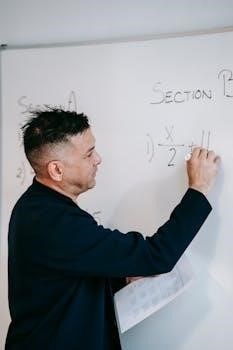Secondary math pacing guides are essential tools that provide a structured roadmap for teaching mathematics. They outline the curriculum’s scope, ensuring all necessary skills and concepts are taught. These guides help teachers efficiently plan and deliver instruction, promoting consistency and student achievement.
Defining a Pacing Guide
A pacing guide, in the context of secondary mathematics, serves as a detailed timeline for instruction. It specifies what content should be taught and when, aligning with curriculum standards and learning objectives. It’s not just a calendar; it’s a strategic plan that breaks down the academic year into manageable units, allocating appropriate time for each topic. These guides ensure a logical flow of concepts, preventing gaps in learning and promoting a cohesive understanding of mathematical principles. Pacing guides help teachers maintain a consistent pace, ensuring that all required material is covered within the designated timeframe. They are often designed to support the scope and sequence of the curriculum, providing a clear path for both educators and students. The guide also facilitates the integration of various mathematical strands like algebra, geometry, and statistics, allowing for a balanced approach to math education. It is a resource that supports effective teaching and learning, promoting a structured and well-planned educational experience.
Importance of Pacing Guides in Math Education
Pacing guides play a crucial role in math education by ensuring a structured and coherent learning experience. They help teachers manage their time effectively, ensuring that all curriculum standards are covered within the academic year. By providing a clear roadmap, these guides prevent the haphazard delivery of content, thereby fostering a more thorough understanding of mathematical concepts. They promote consistency across classrooms, ensuring all students receive equal opportunities to learn. Moreover, pacing guides facilitate the integration of various mathematical strands, such as algebra, geometry, and statistics, allowing for a balanced and comprehensive approach to teaching. These guides also support teachers in planning lessons, assessments, and activities, creating a more efficient learning environment. By aligning instruction with learning objectives, pacing guides assist in measuring student progress and making necessary adjustments to teaching strategies. Ultimately, they contribute to enhanced student outcomes and a more organized educational process. They are vital for ensuring that students are prepared for future math courses and real-world applications.

Key Components of a Secondary Math Pacing Guide
A secondary math pacing guide includes a scope and sequence overview, content strands such as number, algebra, measurement, geometry, and statistics, and probability. These components ensure a comprehensive and structured approach to math education.
Scope and Sequence Overview
The scope and sequence overview is a fundamental aspect of any secondary math pacing guide. It provides a broad perspective on the curriculum, detailing the content and skills that will be covered at each grade level. The scope outlines the breadth of topics, ensuring that all necessary areas of mathematics are addressed, while the sequence dictates the order in which these topics will be taught. This ensures a logical progression of learning, building upon previously acquired knowledge. A well-defined scope and sequence helps teachers understand the overall learning trajectory for students, enabling them to plan lessons that connect concepts and promote deeper understanding. This overview is essential for maintaining consistency across different classes and grade levels. It serves as a roadmap, guiding teachers through the curriculum and ensuring that all students have access to the necessary math skills and knowledge. The sequence also allows for revisiting and reinforcing concepts throughout the academic year, improving retention and application of skills. It should be read in conjunction with the mathematics subject annex to provide a comprehensive understanding of the curriculum.
Content Strands⁚ Number and Algebra
The content strand of number and algebra forms a cornerstone of secondary mathematics. This area focuses on developing students’ understanding of numerical systems, operations, and algebraic concepts. It encompasses topics like number theory, fractions, decimals, and integers, building a strong foundation in numerical reasoning. Algebra introduces students to variables, equations, and functions, enabling them to represent and solve mathematical problems abstractly. This strand emphasizes pattern recognition and the ability to manipulate symbolic expressions. Proficiency in number and algebra is crucial for success in more advanced math courses and applications in real-world scenarios. The pacing guide should ensure students develop a deep understanding of these concepts, progressing from basic operations to more complex algebraic manipulations. This includes working with linear equations, inequalities, and systems of equations, as well as understanding the properties of exponents and radicals. By the end of secondary math, students should be able to use algebraic reasoning to solve various mathematical and real-world problems.
Content Strands⁚ Measurement and Geometry
The measurement and geometry strand in secondary math focuses on developing students’ spatial reasoning and understanding of shapes, sizes, and spatial relationships. This involves learning about units of measurement, both metric and imperial, and applying them to calculate lengths, areas, volumes, and angles. Geometry introduces students to various geometric figures, including lines, angles, triangles, quadrilaterals, circles, and three-dimensional shapes. Students explore the properties of these shapes, learn about geometric theorems and proofs, and develop skills in constructing and analyzing geometric figures. The pacing guide should ensure students can connect geometric concepts to real-world applications, such as architecture, engineering, and design. This strand also emphasizes the development of visualization skills and the ability to solve problems involving geometric relationships. By the end of secondary math, students should be able to apply geometric principles to solve complex problems, understand the relationships between different geometric shapes, and use measurement to analyze and interpret the physical world.
Content Strands⁚ Statistics and Probability
The statistics and probability strand focuses on equipping students with the necessary skills to understand, interpret, and analyze data, while also exploring the concepts of chance and uncertainty. This involves learning how to collect, organize, and present data through various methods, including graphs, charts, and tables. Students will study measures of central tendency (mean, median, mode) and dispersion (range, standard deviation), and learn how to interpret these statistics in context. Probability introduces students to the fundamental concepts of chance, sample space, and events. Students will learn how to calculate probabilities of simple and compound events using various methods, including tree diagrams and probability formulas. Moreover, this strand emphasizes critical thinking, enabling students to make informed decisions based on statistical evidence and understand the potential biases in data collection and interpretation. By the end of secondary math, students should be able to apply statistical and probabilistic reasoning to real-world situations, evaluate statistical claims, and make predictions based on data analysis and probability calculations.

Developing an Effective Pacing Guide
Creating a pacing guide requires careful consideration of curriculum standards and student needs. It involves organizing content logically, allocating sufficient time for each topic, and incorporating diverse instructional strategies. This process ensures a balanced and effective learning experience.
Integrating Number Sense Activities
Integrating number sense activities within a secondary math pacing guide is crucial for building a strong foundational understanding. These activities should not be treated as isolated events but rather as a continuous thread woven throughout the curriculum. Incorporating daily routines that involve number sequences, skip counting from different starting points, and pattern recognition allows students to develop a flexible and intuitive grasp of numerical relationships. For instance, students can explore repeating sequences within and between decades, further solidifying their understanding of place value. Furthermore, using manipulatives and visual aids can help students connect abstract concepts to concrete representations. Problem-solving tasks that require mental math and estimation are also invaluable for fostering number sense. These activities should be age-appropriate and aligned with the curriculum’s scope and sequence, ensuring a smooth progression of skills. By consistently integrating number sense activities, teachers can empower students to approach mathematical challenges with confidence and adaptability.
Incorporating Problem-Solving Strategies
Incorporating problem-solving strategies into a secondary math pacing guide is paramount for developing students’ critical thinking and mathematical reasoning abilities. It’s not enough to just teach concepts; students must learn how to apply them effectively. The pacing guide should integrate a variety of problem-solving approaches, such as working backwards, drawing diagrams, and using logical reasoning. These strategies should be introduced gradually, allowing ample time for students to practice and master each one. Teachers should present problems that encourage students to analyze the situation, identify relevant information, and select the appropriate problem-solving techniques. Emphasizing real-world applications of mathematical concepts can make problem-solving more engaging and meaningful. Furthermore, the pacing guide should include opportunities for students to collaborate and share their problem-solving processes, fostering a deeper understanding of different approaches. By integrating problem-solving throughout the curriculum, educators can help students develop the skills needed for success in mathematics and beyond. Regular reflection on the effectiveness of these strategies is essential for continuous improvement.
Utilizing Data Analysis Techniques
A pacing guide for secondary math should strategically incorporate data analysis techniques, recognizing their increasing importance in today’s world. Students need to develop skills in collecting, organizing, interpreting, and presenting data effectively. The guide should outline a progression of data analysis concepts, starting with basic descriptive statistics, such as mean, median, and mode, and moving towards more complex concepts like standard deviation and correlation. Emphasis should be placed on using visual representations of data, like histograms, scatter plots, and box plots, to identify trends and draw conclusions. The pacing should also allow for students to engage in real-world data analysis projects, giving them opportunities to apply their skills in meaningful contexts. Instruction should include the use of technology, such as spreadsheets and statistical software, to facilitate data analysis. The guide should also address how to critically evaluate data and identify potential biases or limitations. By effectively integrating data analysis techniques, the pacing guide can empower students with the crucial skills needed to make informed decisions and interpret information in a data-driven society. Regular assessment and feedback are crucial for refining students’ data analysis abilities.

Implementing and Adapting the Pacing Guide
Successful implementation requires flexibility, adapting to diverse student needs. Regular progress monitoring allows for necessary revisions. Teacher collaboration is crucial for effective planning, ensuring the guide supports instruction, and is used as a tool to improve.
Adjusting for Student Needs
Flexibility is key when implementing a pacing guide, as students learn at different paces and have varying needs. Teachers must be prepared to make adjustments to ensure that all students can access the material. This might involve slowing down the pace for some groups, providing additional support or scaffolding for those who are struggling, or offering enrichment activities for students who are ready to move on. Differentiated instruction strategies become crucial. It’s important to use data from assessments and observations to identify specific areas where students need additional support or challenge. Consider varying instructional methods, grouping students based on their needs, and providing opportunities for students to work at their own pace. The goal is to create a learning environment where every student feels successful and can achieve the learning objectives outlined in the pacing guide.
Monitoring Progress and Making Revisions

A pacing guide is not a static document; it requires ongoing monitoring and revision to ensure its effectiveness. Regularly assessing student learning through formative and summative assessments is crucial to identify areas where students are excelling or struggling. This data informs adjustments to the pacing and instructional strategies. It’s important for teachers to analyze student work, identify patterns, and address misconceptions. If a significant portion of the class is struggling with a particular concept, the pacing guide may need to be revised to allow for more time and practice. Conversely, if students are mastering concepts quickly, the pacing can be accelerated. This iterative process of monitoring and revision ensures that the pacing guide remains a relevant and effective tool for supporting student learning and teacher planning. It promotes continuous improvement.
Supporting Teacher Planning and Collaboration
A well-designed pacing guide serves as a valuable resource for teachers, streamlining their planning process. By providing a clear roadmap of the curriculum, it allows teachers to focus on instructional delivery and student engagement rather than constantly planning what to teach next. This collaborative tool also facilitates communication among teachers within the same grade level or course, promoting consistency in instruction and assessment. When teachers work together, they can share effective strategies and resources. Pacing guides can be used as a starting point for discussions about instructional practices, lesson planning, and assessment development. This collaboration fosters a sense of shared responsibility for student learning and helps build a strong teaching community. Ultimately, this supportive framework enhances teacher effectiveness and ensures a cohesive and rigorous educational experience for all students.
